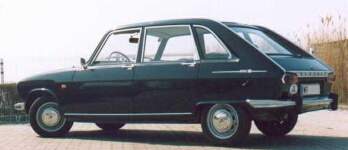
Why R16? Technical My sweet sixteen Interactive Links Home
The history of the Renault 16

The history of the Renault 16 is inseparable with the history of its little brother, the Renault 4. Introduced 1961, the successor of the 4CV had a brand new concept for Renault: front wheel drive, longetudeal engine arranged behind the gearbox, independent suspension on all wheels, rear torsion bars arranged one behind the other, rear door with variable interior space. The concept had great success, and so it was decided to make the R4 30 percent bigger, to have finally again a middle class model - the last big Renault was the Fregatte until 1960, a conventional car with rear wheel drive, similar to the Peugeot 403.


The "project 115", how the cars was named in future, should bring some surprising innovations in its class: for the first time neither conventional boot nor estate but a hatchback with 5 fifth door and variable interior space, front wheel drive and independent suspension on all wheels. In January 1965, the car (which was designated as "Renault 1500" by the motor press until that time) was presented at the Cote d´Azur. Not only the design, drivetrain and suspension were new, the car also was equipped with a hermetic closed cooling system, electric colling fan and voltage regulated alternator - totally new in its class. The harmoic concept convinced the press, so that as a result the Renault 16 was voted to "car of the year 1965".

The R16 was initially equipped with a aluminium alloy engine, capacity 1470 cc, 58 HP, fully synchromesh four-speed-gearboxand was offered in various levels of equipment (L, GL, GLS). 1968 the new presented R16 TS shozuld attract those drivers who felt the 58 HP engine of the R16 as too weak. A new 83 HP (later 85 HP) 1565cc engine and for that time more than complete equipment mad the TS to a full success. 1970 a third version with 3-speed-automatic gearbox was added. The TA had 1565cc capacity and 67 HP, but was otherwise identical with the normal R16.

1971 the first bigger facelift was introduced to the R16 series: The R16 as basis was replaced by the new L and TL, both 67 HP, a new dashboard, adapted to the TS dash was built in.All R16 got a new rear design with bigger lenses, chrome details of the sixties disappeared. The production of the TA was stopped, and was replaced by automatic versions of L, TL and TS.

In October 1973, after 9 years on the market, finally the R16 range was topped with a new model: the R16 TX, with 1648cc/93 HP and again improved equipment was the top of the game till the end. For some customers, the R16 TX filled the space bewteen the smaller R16 models and the six-cylinder R30, which was introduced a year later. The association was also meditated optically, as the R16 TX had twin headlights, like the R30. But, from the marketing sight, the R16 TX was designed as an independent top model of the R16 range.

By the time, the range had been reduced, in September 1976 the production of L and TS was stopped. The last series of TX had less equipment, to push the successors - the R18, technically more or less based on the R12, with up to 78 HP, a lot more conventional, and over this range the R20, with the R16 TX engine or a new 2 litre motor, and on top, as mentioned, the R30. In the year 1980, the successful R16 series was taken out of production after 15 years and over 1,8 millions of produced units.

In the course of the years the R16 had been improved again and again, both for technical and fashion reasons. Some changes were small and to be looked at only, like the chrome details were less and less; others had a solid technical background like the improved braking system in the TS. Therefore, some R16 in original state can be assigned to their year of production easily, just looking at the dashboard or the fresh air intake in front of the windscreen.